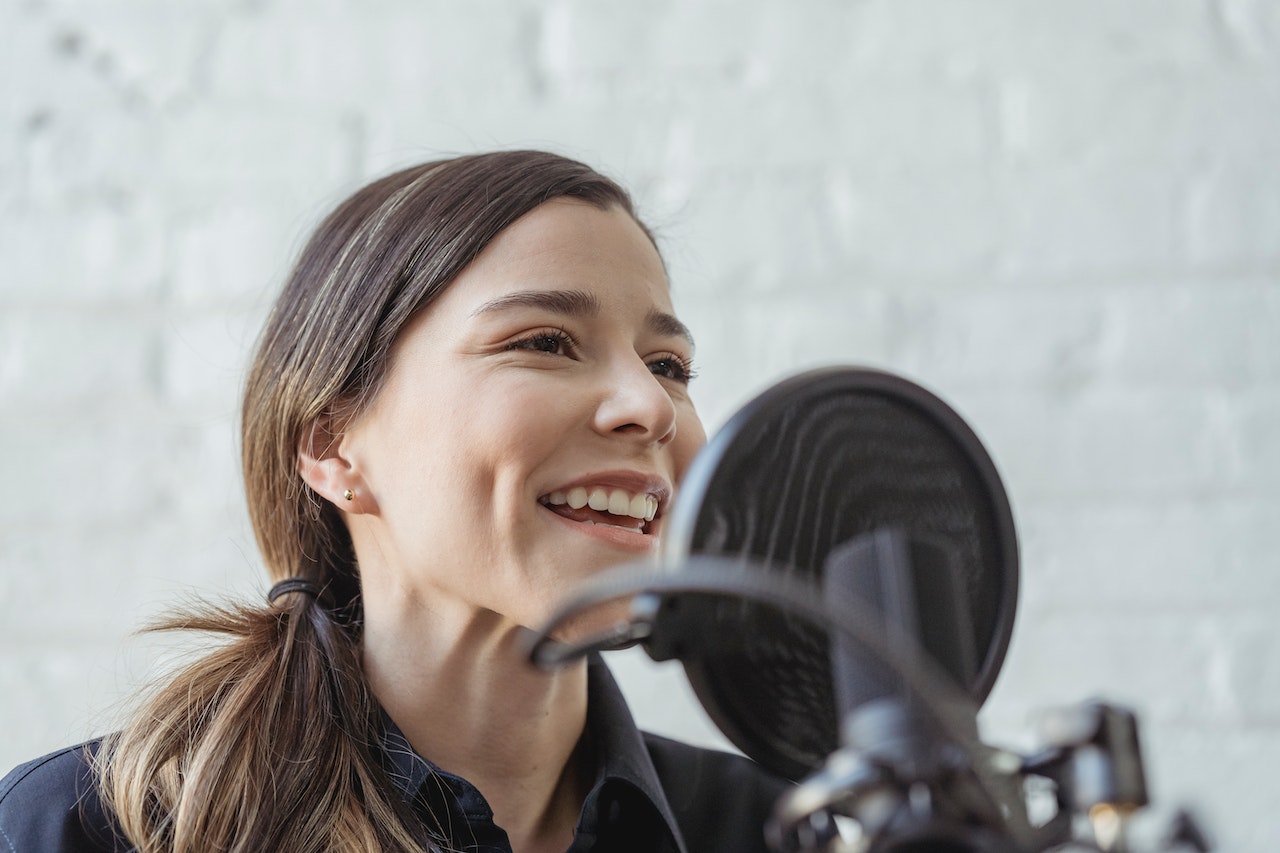If you’ve clicked on this guide, it’s likely that you’re brimming with great ideas and itching to get your voice out there. But you might be wondering, “What’s the best way to record a podcast?” Or maybe you’re asking, “How can I make my podcast sound professional?” Well, I’ve got great news for you. We’re about to dive into everything you need to know about recording a podcast that not only sounds great but keeps your audience hooked.
Whether you’re looking to start a podcast as a passionate hobby or with a business angle in mind, this comprehensive guide is going to give you practical, step-by-step advice on everything from planning your podcast to post-production and even promotion. So, please grab a cup of your favorite brew, sit back, and let’s embark on this podcasting journey together!
Related: Start a Podcast People Will Listen To
Contents
Understanding What Makes A Good Podcast
Starting a podcast is not just about getting the right equipment and hitting the record button; it’s about understanding the ingredients that make up a truly good podcast. From the relevance of your content to the quality of your audio, each aspect plays a crucial role in making your podcast stand out from the crowd.
1. Relevance And Consistency Of Content
The heart of any podcast, indeed, its lifeblood, is the content. What you talk about and how regularly you do it can make or break your podcast. Not only do you need to have content that resonates with your audience, but you also need to consistently provide this content to keep your audience coming back for more. So, how do you ensure your content is relevant and consistent?
Niche and Target Audience
A key aspect of creating relevant content is identifying your niche and understanding your target audience. This is the cornerstone of any successful podcast. You can’t please everyone, and neither should you aim to. Instead, focus on a particular niche that you’re passionate about. This could be anything from marketing strategies to mindfulness meditation or from home cooking tips to hard-hitting investigative journalism.
Once you’ve identified your niche, get to know your target audience. What are their interests? What problems do they face that you can provide solutions for? The better you understand your audience, the more relevant your content will be.
Regularity of Posting
Consistency, my friends, is king. Your audience needs to know they can rely on you for regular content. Whether you decide to publish weekly, bi-weekly, or monthly, stick to that schedule as closely as possible. Regularity builds listener loyalty and engagement, and it also favors you in podcast directories’ algorithms. Of course, maintaining a consistent schedule requires planning, organization, and a bit of discipline, but the payoff is totally worth it.
2. Audio Quality
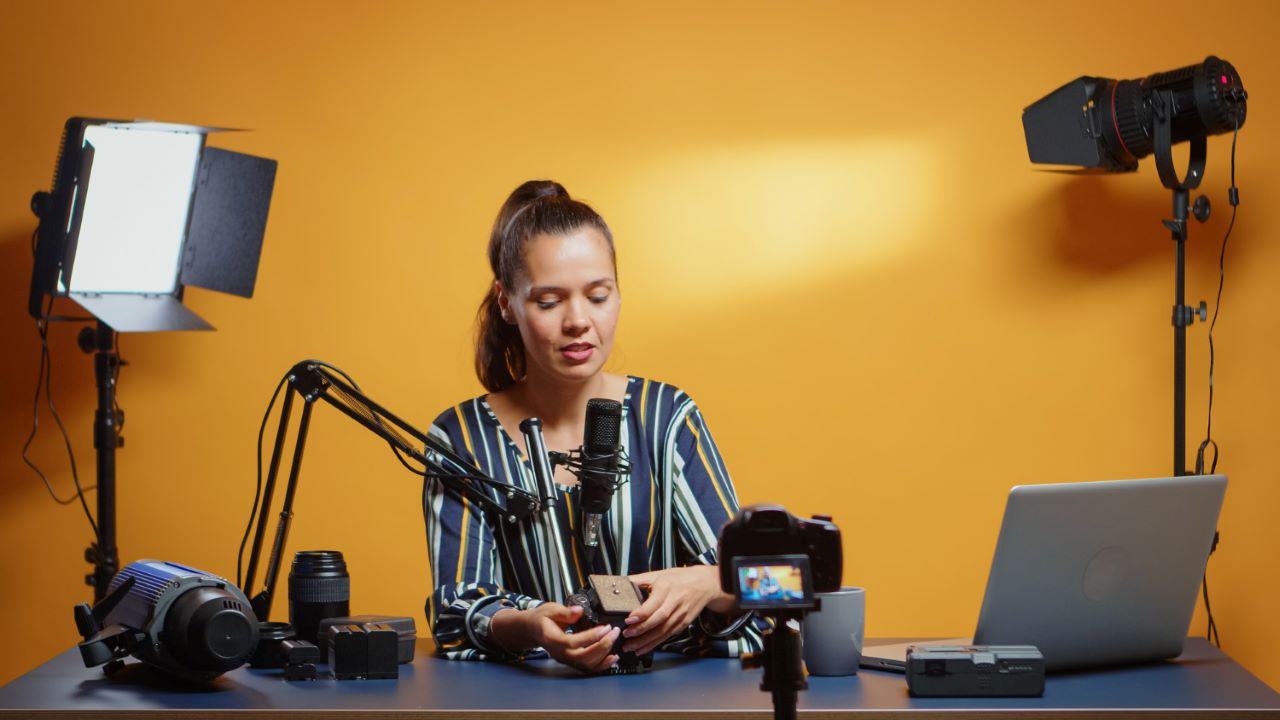
Image by DCStudio on Freepik
In the world of podcasting, audio quality isn’t just a technical detail; it’s an integral part of your audience’s experience. It doesn’t matter how compelling your content is; if your podcast sounds like it was recorded in a tin can, listeners will tune out.
Importance of Good Audio Quality
Good audio quality ensures that your content is heard clearly and appreciated. It shows your listeners that you care about their listening experience, and it lends a level of professionalism to your podcast. While you don’t need to have the same audio quality as a commercial radio station, your podcast should be free of distracting noises and audio issues that can detract from your content.
Common Audio Problems in Podcasts
There are several common audio problems that can affect podcasts, including background noise, echo, popping sounds, and uneven audio levels. Many of these issues can be addressed with the right recording environment, equipment, and techniques, which we’ll delve into later. For now, suffice it to say that good audio quality is essential for a good podcast.
3. Engagement And Interaction
Podcasting isn’t a one-way street. It’s not just about broadcasting your content; it’s about building a community and fostering engagement and interaction with your listeners. This interaction can significantly enrich your podcasting experience and help to grow your audience.
Keeping the Audience Engaged
Keeping your audience engaged goes beyond delivering quality content. It involves crafting a compelling podcast structure, pacing your delivery, using storytelling techniques, and even incorporating interactive elements like listener questions or interviews. Adding a personal touch, sharing anecdotes, and showing vulnerability can also help to create a connection with your audience.
Promoting Interaction with Listeners
Interaction with listeners can take many forms. It could be as simple as asking for feedback or posing a question for listeners to ponder. Or it could involve more elaborate engagement strategies like hosting live Q&A sessions, conducting listener polls, or even inviting listeners to be guests on your podcast. Remember, every interaction is an opportunity to deepen your connection with your audience and increase their investment in your podcast.
Planning Your Podcast
Once you understand what makes a good podcast, the next step is planning. Careful planning can make the difference between a podcast that fizzles out after a few episodes and one that grows and retains a loyal audience. Your planning should include everything from choosing your podcast format and topics to writing scripts and scheduling your recordings.
1. Choosing Your Topic And Format
Before you hit that record button, it’s vital to plan out your podcast’s theme and format. This step may seem basic, but it’s a cornerstone of your podcast’s identity. Trust me, a little planning goes a long way!
Solo, Interview, or Multi-Host Formats
Each podcast format has its own unique benefits. A solo podcast allows you to showcase your expertise and build a personal connection with your audience. An interview-style podcast provides variety and the opportunity to leverage the networks of your guests.
Meanwhile, a multi-host format can create a dynamic listening experience with varied perspectives and lively discussions. There’s no right or wrong choice here. It all depends on your comfort level, resources, and what you think will best resonate with your audience.
Related: 4 Person Podcast Setup
How to Choose a Relevant Topic?
Your podcast’s topic should ideally sit at the intersection of your passion, expertise, and audience interest. It’s a balancing act, for sure. However, choosing a topic that you’re genuinely passionate about will not only make the process enjoyable but also shine through to your listeners. Take time to conduct market research to understand what your target audience wants to learn about.
Look for gaps in the current podcast offerings in your chosen niche. Can you bring something new or different to the table? Remember, your podcast’s topic isn’t set in stone. It can evolve as you grow and learn more about your audience’s preferences.
2. Scripting Your Podcast
While some podcasters might prefer to freewheel, having a script or at least an outline for each episode can help ensure you stay on track and cover all your key points. This doesn’t mean you need to script every word – there’s a balance to be found.
Benefits of Having a Script
A script serves as a roadmap for your episode, ensuring that you stay on topic and remember all crucial points. It can also help manage the length of your episode, keeping it within a listener-friendly timeframe. Plus, if you’re nervous about podcasting, having a script can give you a confidence boost. It’s like having a safety net there to catch you if you lose your train of thought.
Balancing Scripting and Spontaneity
That being said, sticking too rigidly to a script can make your delivery sound robotic or unnatural. It’s essential to strike a balance between scripting and spontaneity. You want to sound natural and conversational, not like you’re reading from a teleprompter.
One way to achieve this is to outline your key points and any important details, then ad-lib the rest. This way, you can ensure a smooth flow of ideas without stifling your natural delivery style.
Check out our post, How to Write a Podcast Script, for an in-depth guide.
3. Scheduling Your Recordings
Consistent publishing is key to growing your podcast audience, and having a recording schedule can help achieve this. A well-planned schedule also allows for more efficient use of your time and resources.
Consistency in Publishing
Whether it’s every week, bi-weekly, or monthly, pick a schedule and stick to it. Consistency helps build an audience as listeners know when to expect new content from you. It also shows your commitment to the podcast, which can build trust with your listeners.
And trust me, podcast directories like Apple Podcasts love consistency too, so sticking to your schedule could also boost your visibility on these platforms.
Factoring in Editing and Post-production Time
When scheduling your recordings, remember to factor in time for editing and post-production. This is often more time-consuming than the recording itself. Consider this: for every hour of recorded content, you might need anywhere from two to five hours for editing, depending on the complexity of your episodes and your proficiency with editing tools.
Factor in this time when planning your podcast schedule to ensure you can consistently meet your publishing commitments.
Setting Up Your Podcasting Equipment
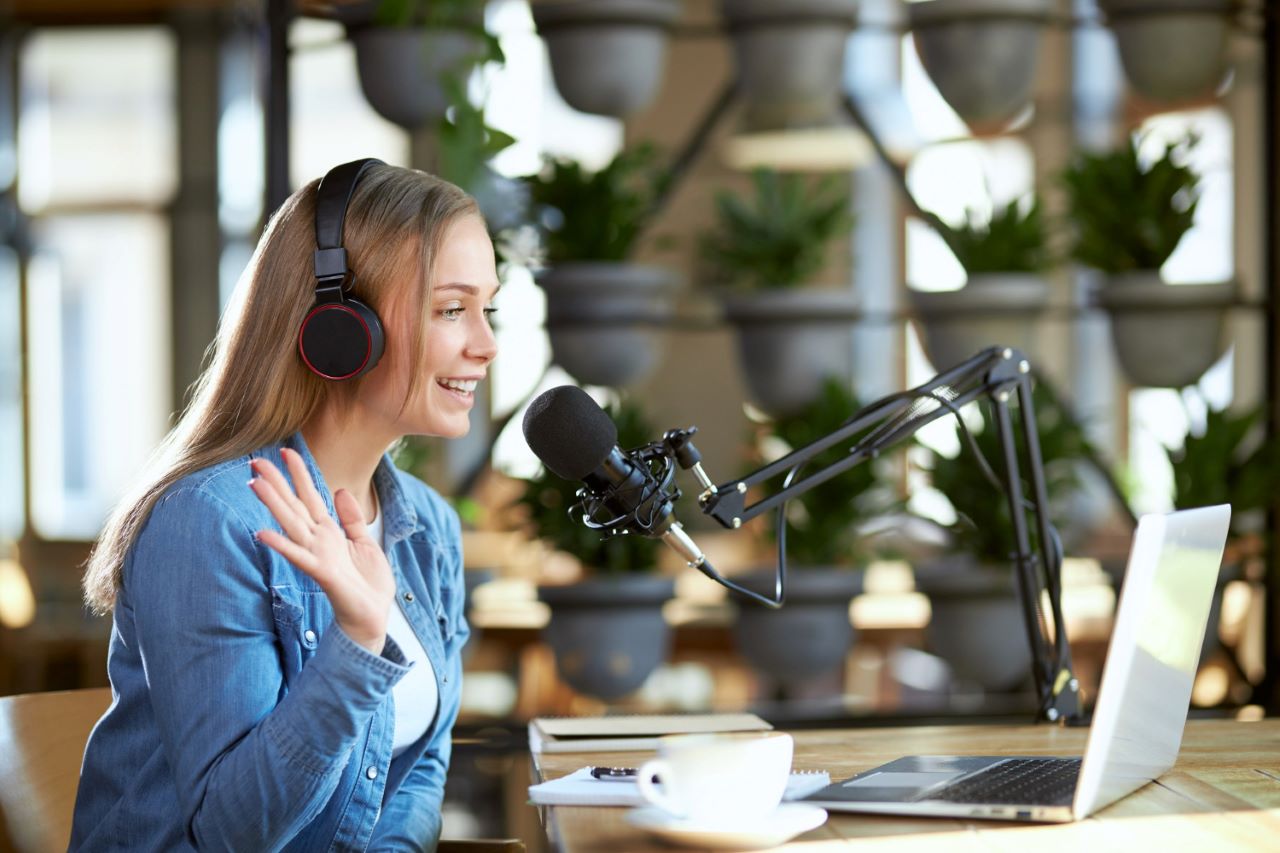
Image by serhii_bobyk on Freepik
Choosing and setting up your podcasting equipment can seem intimidating, especially if you’re new to audio recording. However, it doesn’t have to be complex or expensive. With a few key pieces of equipment and some basic know-how, you can set up a home studio that delivers high-quality sound.
1. Choosing The Right Microphone
Your microphone is your magic wand in podcasting. Choosing the right one can dramatically influence the quality of your audio, so it’s worth investing some time and money here.
Types of Microphones
There are two main types of microphones for podcasting: dynamic and condenser.
Dynamic Mic
Dynamic mics are durable, good at rejecting background noise, and generally more affordable, making them a popular choice for podcasters.
Condenser Mic
Condenser mics, on the other hand, are more sensitive and can capture more detail in your voice, but they also pick up more background noise and tend to be more expensive.
Related: Best Microphones For Recording
Budget Considerations
When choosing a mic, consider your budget. While it’s true that more expensive mics tend to offer better sound quality, don’t let a tight budget deter you from podcasting. You can find several dynamic mics under $100 that provide great value for the price. As your podcast grows, you can always upgrade your equipment.
2. Understanding Audio Interfaces
An audio interface is a device that connects your microphone to your computer, converting the analog signal from your mic into a digital signal that your computer can process. It’s an essential piece of equipment if you’re using a professional XLR microphone.
Role of an Audio Interface
Besides allowing your computer to read the microphone’s signal, an audio interface can also improve your recording quality. It can provide phantom power for condenser mics and allow you to control the gain level of your microphone, helping you to get the cleanest signal possible.
Recommendations for Beginners
For beginners, a simple, one-channel audio interface should suffice. The Focusrite Scarlett Solo and the PreSonus AudioBox are both excellent choices that offer high-quality preamps at a reasonable price.
3. Importance Of Headphones
A good pair of closed-back headphones is another crucial piece of podcasting equipment. Headphones allow you to monitor your audio while recording and are indispensable during the editing process.
Monitoring Audio While Recording
Monitoring your audio while recording lets you catch and correct problems on the spot, saving you time in post-production. Look out for things like distortion, loud breaths, and plosives – those harsh “p” and “b” sounds that can cause a spike in your audio levels.
Closed-back vs Open-back Headphones
While open-back headphones can provide a more natural sound, they also allow more sound to leak out, which could be picked up by your microphone. Therefore, closed-back headphones are generally recommended for recording podcasts. They provide good sound quality and isolate your ears from background noise, allowing you to focus on your recording.
Related: Best Podcast Headphones
4. Other Essential Equipment
A few other items will help you create a professional-sounding podcast, including a pop filter, a microphone stand, and some basic soundproofing.
Pop Filters
A pop filter is a screen that sits between you and your microphone, reducing those plosive sounds that can cause distortion in your audio. They’re a cheap but effective tool to enhance your audio quality. Here’s our top 8 best pop filter for podcasting.
Microphone Stands
A microphone stand can help reduce handling noise and allow you to focus on your delivery. Boom arm stands are a popular choice as they’re adjustable and can be easily mounted to your desk.
Soundproofing Your Recording Space
Proper soundproofing can make a big difference in your audio quality by reducing echo and background noise. While professional soundproofing can get expensive, even a few DIY solutions can improve your sound. These might include recording in a carpeted room with lots of soft furnishings or hanging some heavy blankets or foam panels on the walls.
Best Way To Record A Podcast
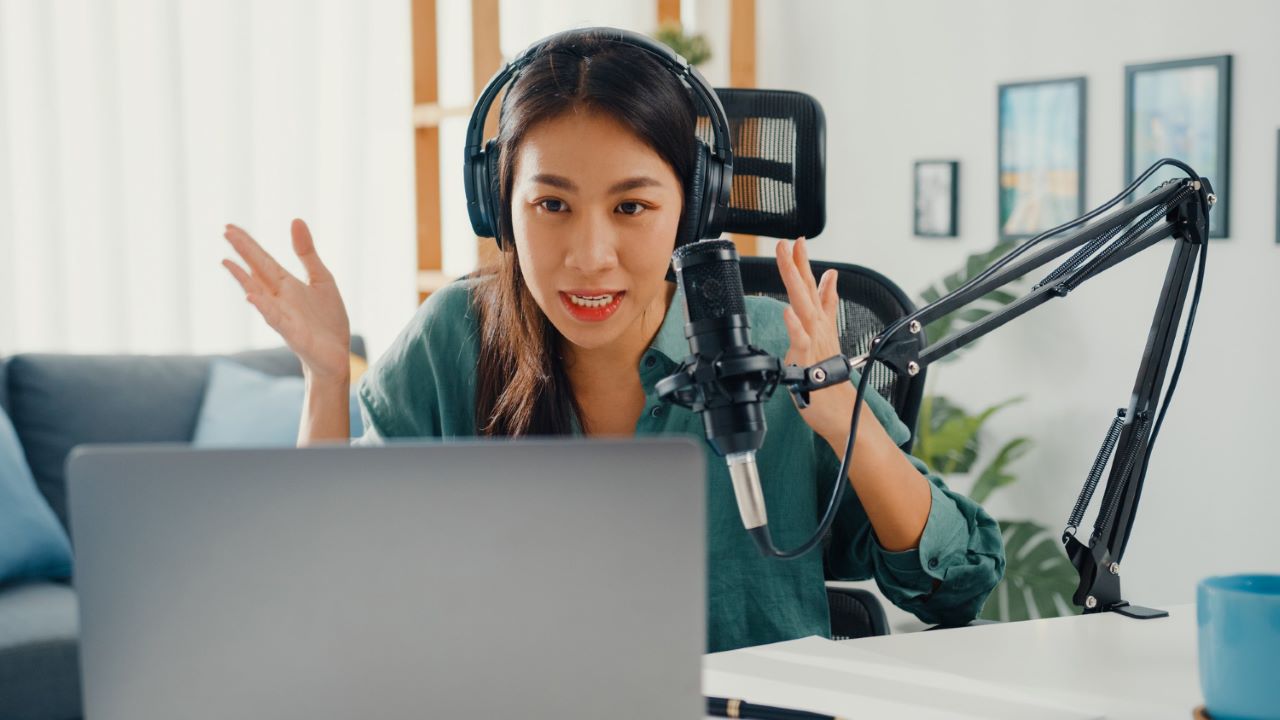
Image by tirachardz on Freepik
You’ve planned your podcast, set up your equipment, and now it’s time to hit that record button! Recording your podcast is where you truly get to connect with your audience. It’s not just about what you say but how you say it. Remember to relax, be yourself, and have fun with the process.
1. Getting Comfortable On The Mic
It’s natural to feel a bit nervous when you first start podcasting. However, there are a few techniques you can use to get more comfortable on the mic and improve your delivery.
Warm-up Exercises
Just like athletes, podcasters can benefit from warming up before hitting the record button. Vocal exercises can help loosen up your vocal cords and improve your diction. It can also be beneficial to do a quick physical warm-up to release tension, which can affect your voice. Even a simple mindfulness practice to calm your nerves can make a big difference in your delivery.
Voice Modulation Tips
Your tone, pace, and inflection can greatly influence how your audience perceives your content. Practice varying your pitch to add interest and emphasis, but be careful not to overdo it – you don’t want to sound like you’re delivering a Shakespearean monologue.
Adjust your speaking pace for clarity and dramatic effect – slow down for important points and speed up during lighter, more casual segments. Don’t be afraid to express emotion in your voice – it can make your podcast more engaging and relatable.
2. Using Recording Software
A good podcast recording software, also known as a digital audio workstation (DAW), is as crucial to your podcasting setup as your microphone or headphones. It’s the tool you’ll use to record, edit, and polish your podcast episodes.
Overview of Popular Recording Software
There’s a wide range of recording software available today, from beginner-friendly options to professional-grade DAWs. Audacity is a popular choice among new podcasters due to its simplicity and the fact that it’s free.
GarageBand, which comes pre-installed on all Mac computers, is another excellent option for beginners. If you’re willing to invest in more advanced software, Adobe Audition offers a comprehensive suite of audio recording and editing tools.
Learning Basic Operations
No matter which software you choose, you’ll need to get comfortable with some basic operations: recording, stopping, starting, saving, cutting, pasting, and exporting. Most DAWs have a plethora of online tutorials and community forums where you can learn these basics. While there might be a learning curve at first, with regular practice, you’ll soon become proficient.
3. Recording Techniques For Better Audio Quality
Once you have your podcasting setup in place and you’re comfortable with your DAW, there are some additional recording techniques you can use further to enhance the audio quality of the audio files.
Optimal Microphone Position
Believe it or not, how you position your microphone can make a significant difference in your audio quality. As a general rule, position your mic about a fist’s distance away from your mouth and speak past it, not directly into it, to reduce plosive sounds. Adjust the angle and distance as needed for comfort and optimal sound.
Controlling Background Noise
A quiet recording environment is critical for clean audio. Turn off fans, air conditioners, and any appliances that might create background noise. Use a pop filter to reduce plosives, and consider some simple soundproofing to minimize echo. Remember, it’s easier to prevent noise at the source than to remove it in post-production.
4. Remote Recording Tips
If you’re recording remote interviews or co-hosting with someone in a different location, there are a few additional considerations to keep in mind.
Software for Remote Podcasting
You’ll need software that allows you to record both sides of the conversation. Zoom is a popular option due to its simplicity and the quality of its recordings. Zencastr and SquadCast are more specialized tools for remote podcasting that record each person’s audio locally for higher quality.
Ensuring Audio Consistency
When recording podcast remotely, it’s important to ensure consistent audio quality between all speakers. Ask your guest or co-host to use a decent microphone if possible and to record in a quiet environment. You may also want to record a quick test call before the actual recording to check the audio levels of your audio file and address any potential issues.
Related: Best Podcast Recording Software
Post-Production Of Your Podcast
Post-production, or editing, is where you polish your podcast and make it sound professional. Here, you’ll remove any mistakes, awkward pauses, or unnecessary content, and you can add in music, sound effects, and other elements to enhance your podcast.
1. Basic Audio Editing Techniques
There are a few basic editing techniques that every podcaster should know: noise reduction, adjusting levels, cutting and trimming, and equalization.
Removing Background Noise
Even with the best precautions, some background noise is inevitable. Fortunately, most DAWs have a noise reduction feature. This tool allows you to identify a section of background noise in your recording and then automatically reduce that noise across your entire episode.
Adjusting Levels for Consistent Volume
Consistent volume across your podcast episode ensures a comfortable listening experience for your audience. Look for sections where the volume spikes or drops and use your DAW’s gain or volume tools to adjust those sections. You can also use a normalization effect to set a consistent maximum volume for your entire episode.
If you’re using Audacity, you can check out How To Edit A Podcast In Audacity for basic editing tips.
2. Advanced Editing Options
Once you’re comfortable with the basics, there are some additional editing techniques that can take your podcast to the next level.
Introduction to Audio Effects
Adding sound effects or music can help create mood and add interest to your podcast. Consider an intro and outro tune or a jingle for segment transitions. Just ensure any music or sound effects you use are royalty-free or that you have permission to use them.
Adding Intro and Outro Music
A catchy intro and outro can make your podcast more memorable and professional. It’s also a chance to reinforce your brand and set the tone for your episode. When adding music to your podcast, be mindful of the volume. You want it to be audible but not overpowering. Use your DAW’s fade-in and fade-out tools to ensure a smooth transition between your music and your voice.
3. Finalizing And Exporting Your Podcast Episode
With all the recording, editing, and fine-tuning done, it’s time to wrap up and get your podcast episode ready for the world to hear!
Final Listening for Quality Check
Before you hit that export button, give your podcast one final listen. This is your chance to catch any mistakes, audio glitches, or volume inconsistencies that you might have missed during editing. It’s always a good idea to listen with headphones, as they’ll give you the most accurate representation of what your listeners will hear.
Choosing the Correct Export Format
Most podcast platforms accept MP3 files, as they offer a good balance of sound quality and file size. When exporting your podcast, aim for a bit rate of 128 kbps. This will provide decent audio quality without making the file size too large. Remember to name your file appropriately and include metadata like episode number, title, and your podcast’s name.
Uploading And Promoting Your Podcast
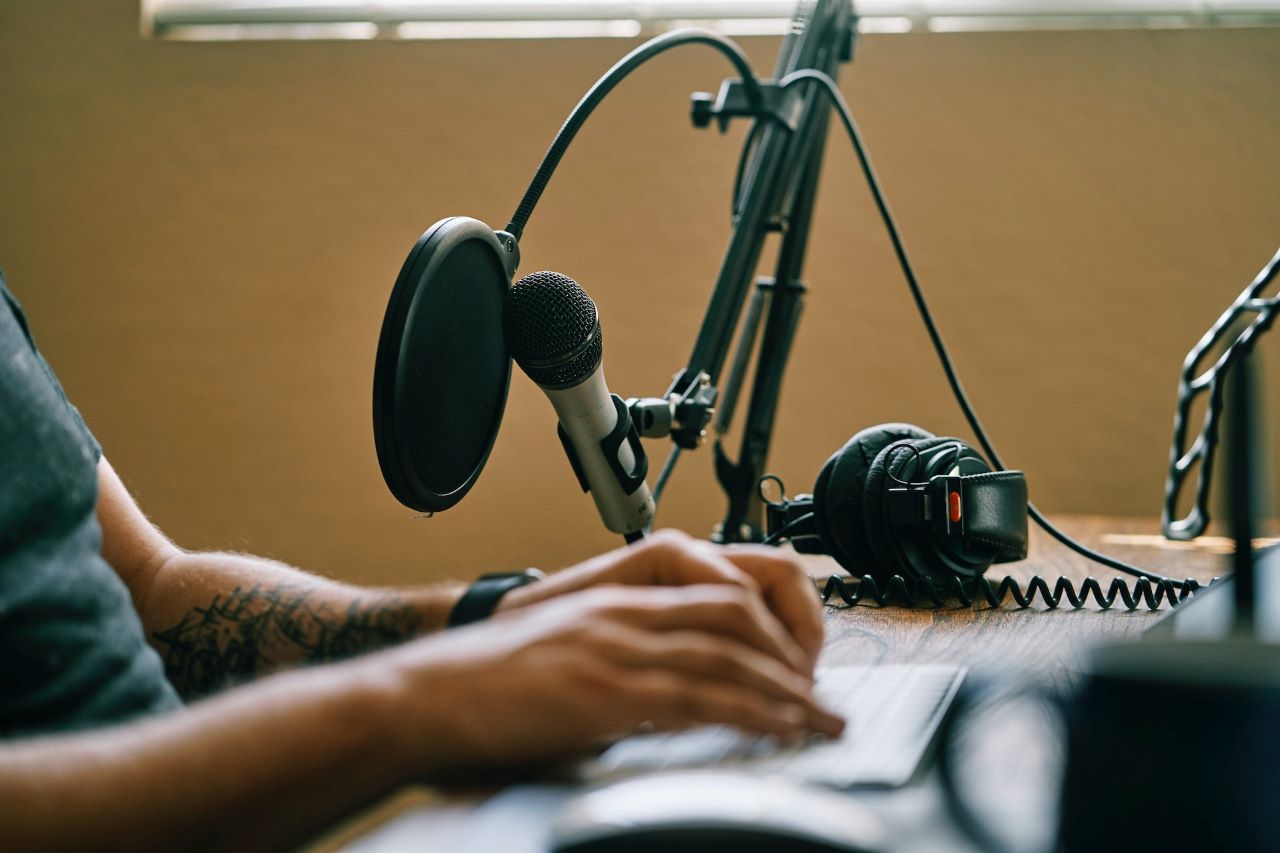
Photo by ConvertKit on Unsplash
Now that you’ve got your polished podcast episode ready, it’s time to upload it to a podcast hosting platform and start attracting listeners!
1. Choosing A Podcast Hosting Platform
There are many podcast hosting platforms out there, each with its own set of features, pricing structures, and distribution options. Some popular choices are Libsyn, Podbean, and Buzzsprout.
Overview of Podcast Hosting Platforms
Libsyn is a veteran in the podcast hosting game, offering robust analytics and distribution to all major podcast directories. Podbean offers unlimited hosting services, detailed analytics, and easy publishing tools. Buzzsprout offers advanced features like automatic episode optimization, easy publishing to all major directories, and an intuitive interface.
Factors to Consider when Choosing a Platform
When choosing a podcast hosting platform, you’ll want to consider the cost, ease of use, analytics, storage limits, and distribution options. It’s also a good idea to look at any additional features like a website builder, social media integration, or monetization options. Read our post, Best Podcast Hosting Platforms, for helpful ideas.
2. SEO And Metadata For Your Podcast
SEO and metadata are critical for increasing the visibility of your podcast and attracting new listeners.
The Importance of Metadata
Metadata is the information that comes with your podcast file. This includes your podcast title, episode titles, description, and tags. Well-optimized metadata can help your podcast appear in relevant searches, both on podcast platforms and search engines, increasing your visibility and attracting more listeners.
Basics of Podcast SEO
Like website SEO, podcast SEO involves optimizing your content and metadata with relevant keywords. Do keyword research to understand what your potential listeners might be searching for, and incorporate these keywords in your episode titles, descriptions, and show notes.
3. Promoting Your Podcast
After all the hard work you’ve put into creating your podcast, you’ll want to ensure it reaches as many people as possible.
Utilizing Social Media
Social media is a powerful tool for promoting your podcast. Create a social media strategy that involves regularly sharing your episodes, engaging with your listeners, and building a community around your podcast. You can also reach out to influencers or other podcasters in your niche for collaboration or promotion opportunities.
Encouraging Listener Reviews and rating
Reviews and ratings play a significant role in your podcast’s discoverability. Encourage your listeners to leave reviews and ratings on Apple Podcasts or wherever they consume your podcast. Not only will this boost your rankings, but it also provides valuable feedback for improving your show.
Conclusion
Venturing into the world of podcasting may seem like a daunting task, but with the right understanding, careful planning, and suitable equipment, the process can become smoother and enjoyable. Your podcast is a reflection of your passion creativity and a unique opportunity to connect with an audience that shares your interests. Remember, the goal isn’t perfection from the get-go but consistent growth and improvement over time.
The journey of creating a podcast from scratch to recording, editing, and promoting it is filled with learning experiences and opportunities for innovation. Whether you’re podcasting for fun, to promote a business, or to establish yourself as a thought leader, your voice matters, and the world deserves to hear it.
Armed with these insights, go ahead and bring your podcasting dreams to life. Be patient with yourself, cherish the journey, and here’s to your podcasting success.

